Related Research Articles
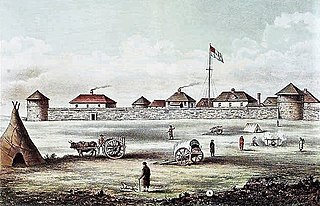
Fort Garry, also known as Upper Fort Garry, was a Hudson's Bay Company trading post at the confluence of the Red and Assiniboine rivers in what is now downtown Winnipeg.

The Red River Colony, also known as Assiniboia, was a colonization project set up in 1811 by Thomas Douglas, 5th Earl of Selkirk, on 300,000 square kilometres (120,000 sq mi) of land in British North America. This land was granted to Douglas by the Hudson's Bay Company in the Selkirk Concession. It included portions of Rupert's Land, or the watershed of Hudson Bay, bounded on the north by the line of 52° N latitude roughly from the Assiniboine River east to Lake Winnipegosis. It then formed a line of 52° 30′ N latitude from Lake Winnipegosis to Lake Winnipeg, and by the Winnipeg River, Lake of the Woods and Rainy River.

The Battle of Seven Oaks was a violent confrontation in the Pemmican War between the Hudson's Bay Company (HBC) and the North West Company (NWC), rivals in the fur trade, that took place on 19 June 1816, the climax of a long dispute in western Canada. The Métis people fought for the North West Company, and they called it "the Victory of Frog Plain".

Thomas Douglas, 5th Earl of Selkirk FRS FRSE was a Scottish peer. He was noteworthy as a Scottish philanthropist who sponsored immigrant settlements in Canada at the Red River Colony.

In January 1814 Governor Miles MacDonell, appointed by Thomas Douglas, 5th Earl of Selkirk issued to the inhabitants of the Red River area a proclamation which became known as the Pemmican Proclamation. The proclamation was issued in attempt to stop the Métis people from exporting pemmican out of the Red River district. Cuthbert Grant, leader of the Métis, disregarded MacDonell's proclamation and continued the exportation of pemmican to the North West Company. The proclamation overall, became one of many areas of conflict between the Métis and the Red River settlers. Thomas Douglas, 5th Earl of Selkirk had sought interest in the Red River District, with the help of the Hudson's Bay Company as early as 1807. However, it was not until 1810 that the Hudson's Bay Company asked Lord Selkirk for his plans on settling in the interior of Canada.
Assiniboia District refers to two historical districts of Canada's Northwest Territories. The name is taken from the Assiniboine First Nation.

Robert Semple was Governor of the territories owned by the Hudson's Bay Company from autumn 1815 until his death.

William Mactavish was a Scottish Hudson's Bay Company clerk, accountant, and chief trader. Mainly known for his dual-position as Governor of Assiniboia, and Governor of Rupert's Land, he played a major role in the development of Western Canada. Mactavish is frequently criticized for his role in the Red River Rebellion.

Fort Douglas was the Selkirk Settlement fort and the first fort associated with the Hudson's Bay Company near the confluence of the Red and Assiniboine rivers in today's city of Winnipeg. Named for Thomas Douglas, 5th Earl of Selkirk, founder of the Selkirk Settlement, the fort was built by Scottish and Irish settlers beginning in 1813. Completed in 1815, it was in the immediate vicinity of the North West Company establishment, Fort Gibraltar.
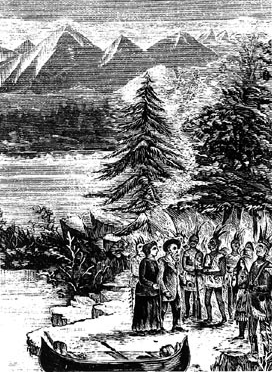
Marie-Anne Lagimodière was a French-Canadian woman noted as both the grandmother of Louis Riel, and as the first woman of European descent to travel to and settle in what is now Western Canada.

The Métis flag was first used by Métis resistance fighters in Rupert's Land before the 1816 Battle of Seven Oaks. According to only one contemporary account, the flag was "said to be" a gift from the North West Company in 1815, but no other surviving accounts confirm this. Both the red and blue versions of the flag have been used to represent the political and military force of the Métis since that time. The Métis flag predates the Flag of Canada by at least 150 years, and is the oldest patriotic flag that is indigenous to Canada.
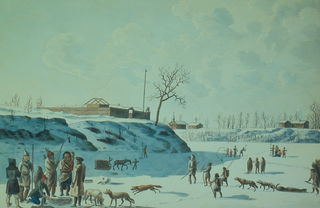
Fort Gibraltar was founded in 1809 by Alexander Macdonell of Greenfield of the North West Company in present-day Manitoba, Canada. It was located at the confluence of the Red and Assiniboine rivers in or near the area now known as The Forks in the city of Winnipeg. Fort Gibraltar was renamed Fort Garry after the merger of North West Company and the Hudson's Bay Company in 1821, and became Upper Fort Garry in 1835.
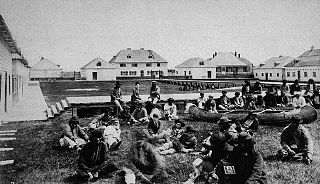
Norway House is a population centre of over 5,000 people, some 30 km (19 mi) north of Lake Winnipeg, on the bank of the eastern channel of Nelson River, in the province of Manitoba, Canada. The population centre shares the name Norway House with the northern community of Norway House and Norway House 17, a First Nation reserve of the Norway House Cree Nation. Thus, Norway House has both a Chief and a Mayor.

The Selkirk Concession was a land grant issued by the Hudson's Bay Company (HBC) to Thomas Douglas, 5th Earl of Selkirk, in 1812. The Hudson's Bay Company held a commercial monopoly in Rupert's Land, consisting of the entire Hudson Bay drainage basin. The Selkirk Concession, also known as Selkirk's Grant, included a large section of the southwest area of Rupert's Land, bounded: on the north by the line of 52° N latitude roughly from the Assiniboine River east to Lake Winnipegosis, then by the line of 52° 30′ N latitude from Lake Winnipegosis to Lake Winnipeg; on the east by the Winnipeg River, Lake of the Woods and Rainy River; on the west roughly by the current boundary between modern Saskatchewan and Manitoba; and on the south by the rise of land marking the extent of the Hudson Bay watershed. This covered portions of present-day southern Manitoba, northern Minnesota and eastern North Dakota, in addition to small parts of eastern Saskatchewan, northwestern Ontario and northeastern South Dakota.

The history of Manitoba covers the period from the arrival of Paleo-Indians thousands of years ago to the present day. When European fur traders first travelled to the area present-day Manitoba, they developed trade networks with several First Nations. European fur traders in the area during the late-17th century, with the French under Pierre Gaultier de Varennes, sieur de La Vérendrye set up several trading post forts. In 1670, Britain declared sovereignty over the watershed of Hudson's Bay, known as Rupert's Land; with the Hudson's Bay Company granted a commercial monopoly over the territory.
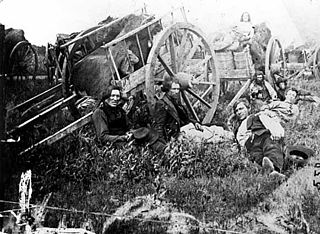
The Red River Trails were a network of ox cart routes connecting the Red River Colony and Fort Garry in British North America with the head of navigation on the Mississippi River in the United States. These trade routes ran from the location of present-day Winnipeg in the Canadian province of Manitoba across the Canada–United States border, and thence by a variety of routes through what is now the eastern part of North Dakota and western and central Minnesota to Mendota and Saint Paul, Minnesota on the Mississippi.

The history of Winnipeg comprises its initial population of Aboriginal peoples through its settlement by Europeans to the present day. The first forts were built on the future site of Winnipeg in the 1700s, followed by the Selkirk Settlement in 1812. Winnipeg was incorporated as a city in 1873 and experienced dramatic growth in the late 19th and early 20th centuries. Following the end of World War I, the city's importance as a commercial centre in Western Canada began to wane. Winnipeg and its suburbs experienced significant population growth after 1945, and the current City of Winnipeg was created by the unicity amalgamation in 1972.
This is a timeline of the history of Winnipeg.

The Pemmican War was a series of armed confrontations during the North American fur trade between the Hudson's Bay Company (HBC) and the North West Company (NWC) in the years following the establishment of the Red River Colony in 1812 by Lord Selkirk. It ended in 1821 when the NWC merged with the HBC.
Most of the following timelines for Manitoba's history is taken from either the Manitoba Historical Society, or from the Heritage Manitoba and the Gimli Municipal Heritage Advisory Committee, as adapted from a three-volume history of Manitoba published in 1993 titled Manitoba: 125.
References
- 1 2 3 4 Roy C. Dalton (1979–2016). "COLTMAN, WILLIAM BACHELER, businessman, jp, politician, and office holder; b. in England; d. 2 Jan. 1826 in London". Dictionary of Canadian Biography (online ed.). University of Toronto Press. Retrieved 2020-03-23.
- 1 2 3 4 "Memorable Manitobans: William Bachelor Coltman (?-1826)". Manitoba Historical Society . Retrieved 2020-03-23.
He was appointed to the Lower Canadian Executive Council in 1812. In 1816 he and John Fletcher were appointed as justices of the peace for the Indian territory of the Northwest by Governor Sherbrooke. Subsequently they were given a special commission to investigate the fur-trade war in the West, which had recently produced the Battle of Seven Oaks.
- ↑ "President's Message" (PDF). Le Metis. Retrieved 2020-03-23.
However, the British government's own independent investigator, Lieutenant Colonel William B. Coltman, concluded the Métis led by Cuthbert Grant only fired in selfdefense after Governor Semple and his men fired on them. They had rode out to meet Grant and his men with guns to prevent them from carrying goods to their trading partners on Lake Winnipeg.
- ↑ Bruce Cherney (2015-01-23). "January 10, 1817 — Macdonell, who recaptured Fort Douglas, only served as the governor of the settlement for a few months afterward". Winnipeg Real Estate News. Retrieved 2020-03-23.
Essentially, the "private" war (a term used by Coltman) created plenty of unhappy shareholders in both companies, who wanted the conflict resolved so that they could again get down to the business of making money.